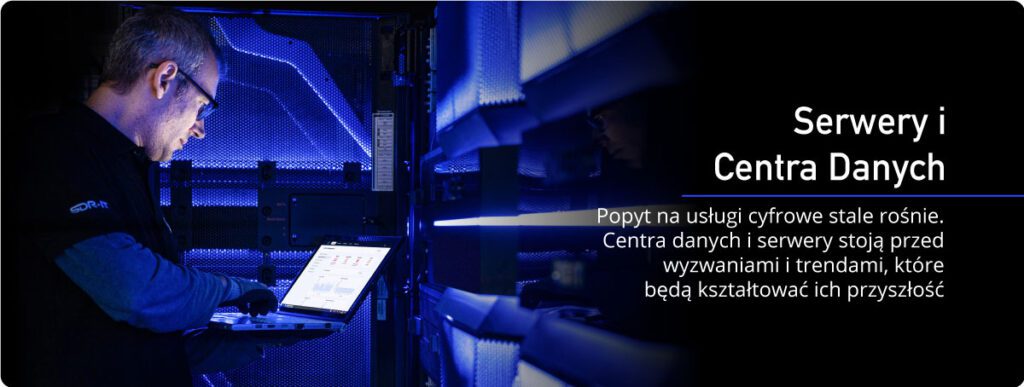/Serwery i Centra Danych


Centra danych oraz serwery stanowią kręgosłup współczesnego świata cyfrowego. Codziennie przechowują, przetwarzają i przesyłają ogromne ilości danych, umożliwiając nam dostęp do informacji, komunikację z innymi i prowadzenie działalności w Internecie. W tym artykule przedstawimy znaczenie centrów danych i serwerów, sposób ich działania, a także wyzwania oraz trendy kształtujące ich przyszłość.
Czym jest centrum danych?
Centrum danych jest obiektem używanym do przechowywania systemów komputerowych i powiązanych komponentów, takich jak systemy telekomunikacyjne oraz pamięci masowej. Centra danych są zaprojektowane w celu zapewnienia wysokiego poziomu dostępności, bezpieczeństwa i niezawodności, aby zapewnić, że przechowywane i przetwarzane dane są zawsze dostępne i chronione.
Występują one w różnych rozmiarach, od małych serwerowni po duże obiekty korporacyjne, które mogą zajmować setki metrów kwadratowych. Niektóre centra danych są własnością i są obsługiwane przez pojedyncze organizacje, podczas gdy inne są obsługiwane przez zewnętrznych dostawców usług i oferują usługi hostingowe dla wielu klientów.
Jak działają serwery?
Serwery stanowią podstawę centrów danych, zapewniając moc obliczeniową potrzebną do przetwarzania i przechowywania danych. Serwer to system komputerowy, który jest przeznaczony do świadczenia określonych usług lub zasobów dla innych komputerów lub urządzeń podłączonych do sieci.
Serwery mogą pełnić wiele funkcji, takich jak hosting stron internetowych, uruchamianie aplikacji oraz przechowywanie i przetwarzanie danych. Serwer może być maszyną fizyczną lub maszyną wirtualną, która działa na maszynie fizycznej. Technologia wirtualizacji umożliwia uruchomienie wielu wirtualnych serwerów na jednej maszynie fizycznej, co pozwala organizacjom zmaksymalizować zasoby obliczeniowe i zmniejszyć koszty.


Wyzwania i trendy
Wraz z ciągłym wzrostem zapotrzebowania na usługi cyfrowe, centra danych i serwery stoją przed kilkoma wyzwaniami i trendami, które będą kształtować ich przyszłość.
- Jednym z podstawowych wyzwań jest potrzeba większej efektywności energetycznej. Centra danych zużywają ogromne ilości energii, a wraz ze wzrostem liczby centrów danych rośnie ich wpływ na środowisko. Aby sprostać temu wyzwaniu, centra danych stosują bardziej energooszczędne technologie, takie jak zaawansowane systemy chłodzenia, oraz wykorzystują odnawialne źródła energii, takie jak energia słoneczna i wiatrowa.
- Kolejnym wyzwaniem jest potrzeba większego bezpieczeństwa. Naruszenie danych może mieć poważne konsekwencje, zarówno dla organizacji, jak i osób prywatnych. Centra danych wdrażają bardziej rygorystyczne środki bezpieczeństwa, takie jak uwierzytelnianie wieloczynnikowe i szyfrowanie, w celu ochrony przed cyberatakami.
- Jeśli chodzi o trendy, “edge computing” wyłania się jako istotny trend w architekturze centrów danych i serwerów. Polega on na przetwarzaniu danych bliżej źródła, zmniejszając opóźnienia i poprawiając wydajność. Jest to szczególnie ważne dla aplikacji wymagających przetwarzania danych w czasie rzeczywistym, takich jak pojazdy autonomiczne i automatyka przemysłowa.
Podsumowanie
Centra danych i serwery są podstawowymi elementami infrastruktury cyfrowej, która wspiera nasz współczesny świat. Umożliwiają nam dostęp do ogromnych ilości informacji i ich przechowywanie, a także zapewniają moc obliczeniową niezbędną dla krytycznych aplikacji i usług. Wraz z ciągłym wzrostem zapotrzebowania na usługi cyfrowe, centra danych i serwery będą musiały stawić czoła ciągłym wyzwaniom i trendom, które będą kształtować ich przyszłość. Przyjmując innowacyjne technologie i strategie, centra danych i serwery mogą nadal ewoluować i spełniać potrzeby naszego szybko zmieniającego się cyfrowego świata.









